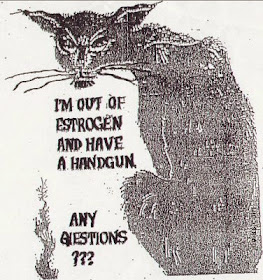Physical
· Hot flashes
· Fatigue
· Headaches/migraines
· Night sweats
· Vaginal and/or bladder
infections
· Incontinence
· UTI’s
· Forgetfulness
· Difficulty falling asleep
· Poor concentration
· Forgetfulness
· Decreased verbal skills
· Irregular bleeding
· Testosterone imbalance
· Lower libido
· Painful intercourse
· Osteoporosis
· Episodes of rapid heartbeat
Emotional
· Depression
· Minor anxiety
· Emotional instability
· Feelings of despair
· Crying easily
Properties of
Estrogens
· Creates endometrium
· Development at puberty
· Regulates menstrual cycle
· Plumps vaginal tissue and reduces vaginal
dryness
· Slows bone loss
· Can help reduce incidence of heart attacks
· Anti-aging factor
· Increases sensitivity of progesterone receptors
· Affects more than 300 tissue systems of
the body
· Uplifts mood
· Lowers LDL
· Increases HDL
· Decreases lipoprotein(a) and homocysteine
· Affects every neurotransmitter in the
brain; including seratonin, dopamine, GABA
· Adds moisture to skin
· Affects brain function responsible for
memory and motivation
· Needed for verbal memory and to learn
new concepts, reasoning, and fine motor skills
Symptoms
Associated with Estrogen Dominance
· Breast cyst/breast pain
· PMS
· Irregular bleeding
· Fluid retention
· Headaches
· Breast adenomas
· Gall bladder problems
· Blood sugar problems
· Nutrient deficiencies
· Nervous/Irritability
· Low libido
· Fibroids
· Hormonal cancers
· Heavy menstruation
· Bloating
· Weight gain
· Nausea
· Endometriosis
· Thyroid problems
· Mood swings
· Sleep disturbances
· Sugar cravings
Symptoms of Excess
Androgens
Physical
· Acne/oily skin
· Facial hair
· Deepened voice
· Ovarian Cyst
· Hypoglycemia
· Mid-cycle pain
· Low HDL
· Thinning scalp hair
· Breast cancer risk
· Painful nipples
Emotional
· Agitated
· Angry
· Irritable
Symptoms of
Androgen Deficiency
Physical
· Loss of libido
· Impaired sexual function
· Aches/pain/arthritis
· Incontinence
· Thinning skin
· Thin tissue of the vulva and labia
· Loss of muscle tone
· Wrinkled skin
· Lichen slcerosis
· Hot flashes
Emotional
· Depression
· Lack of drive and confidence
· Demotivation
Properties of
Androgens
· Cardiovascular protection
· Help with brain function
· Build bones
· Enhances libido
· Build Muscle
· Anti-aging to skin
· Antidepressant
Symptoms
Associated with Progesterone Deficiency
Physical
· Fibrocystic breasts or breast pain
· Anxiety
· Fluid Retention
· Stressed Easily
· Weight gain
· Irritability
· Break-though-bleeding
· PMS
· Low Body Temperature
· Hair Loss
· Headaches/migraines
· Endometriosis
· Sleep Disturbances
· Heavy Periods
· Cramps
· Fibroids
· Hypothyroidism
· Bone Loss
· Irregular cycle/spotting between cycles
· Infertility
Emotional
· Anxiety
· Over Reacting
· Easily alarmed
· Stressed
· Feelings of confusion
· Mood swings
· Irritability
· Nervous
· Jittery
· Depression
Roles and
Properties of Progesterone
· Decreases menstrual bleeding
· Decreases fat storage
· Anti-cancer; especially protective of
the breast
· Increases body supply of oxygen
· Helps prevent hardening of the arteries
· Improves brain structure and function,
memory
· Increases metabolic rate
· Helps regulate water retention
· Required for conception and gestation
· Increases intelligence of fetus
· Mild sedative in large doses
· Protects against miscarriage
· Prevents PMS
· Stimulates new bone formation
· Anti-aging to skin
· Inhibits Fibrocystic Breast Disease
· Natural antidepressant
· Facilitates thyroid hormone action
· Normalizes blood sugar levels
· Reduces spotting
· Tones blood vessels
· Reduces irritability and anxiety
· Reduces testosterone imbalance
· Prevents endometrial cancer
· Anti-aging hormone
· Useful in some cases of seizure disorder
· Helps prevent high blood pressure
· Reduces risk of autoimmune diseases
· Increases (Ig-E) to help prevent sinus,
respiratory, vaginal infections and allergic reactions
· Increases sensitivity of estrogen
receptors
· Natural diuretic
· Raises HDL, lowers triglycerides
· Restores sex drive
· Functions as a precursor to
corticosteriods and other steroidal hormones
· Blocks estrogen’s side effects and
excessive estrogen
· Increases endurance during exercise
· Calms and protects nervous system
· Protective effect on brain chemistry
· Reduces cravings for sweets/carbs
· Thymus gland depends on progesterone
· Most protective hormone the body produces
· Improve efficiency of the heart
· Basic hormone of adaptation and resistance
to stress
· Restores normal sleep patterns
· Enhances number of insulin receptors on cells
· Used by adrenals to produce anti-stress hormones"
from http://www.jacemedical.com/articles/Hormonal%20Health%20and%20Balance%20Information.pdf



